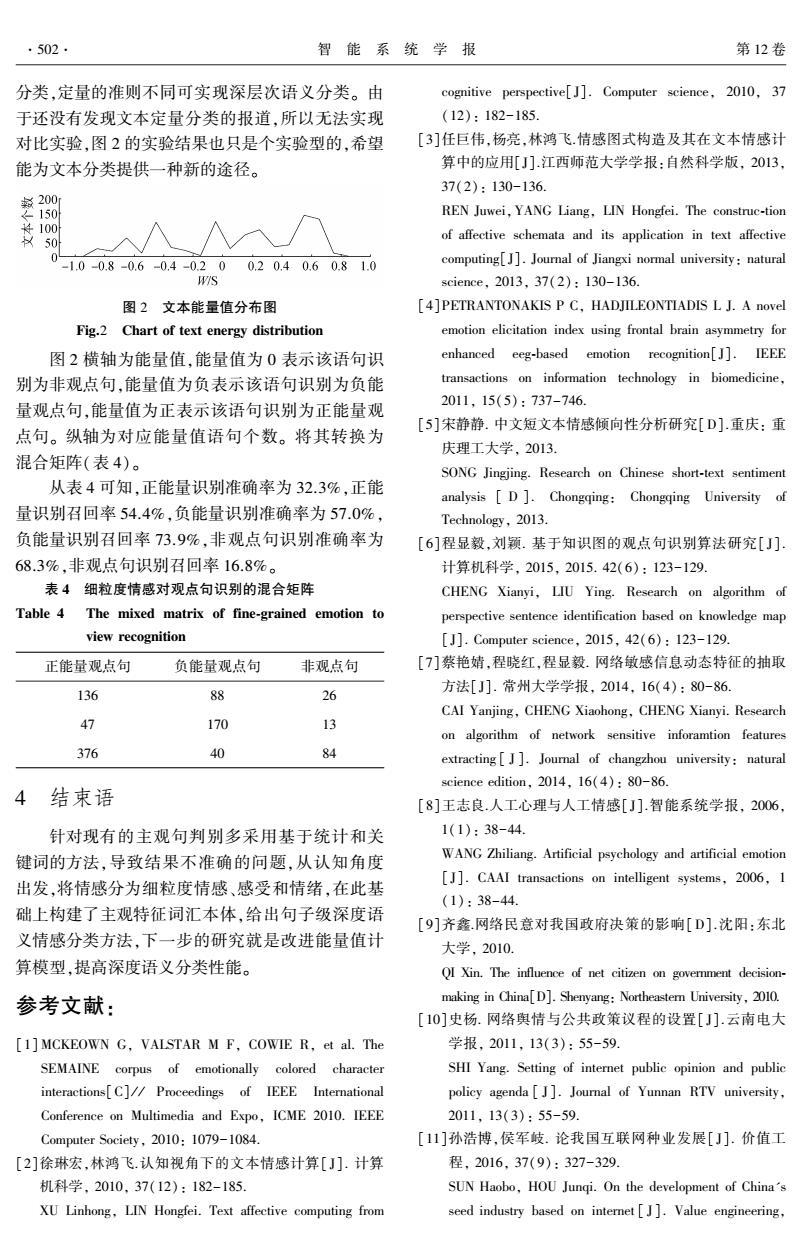正在加载图片...

.502 智能系统学报 第12卷 分类,定量的准则不同可实现深层次语义分类。由 cognitive perspective[J].Computer science,2010,37 于还没有发现文本定量分类的报道,所以无法实现 (12):182-185 对比实验,图2的实验结果也只是个实验型的,希望 [3]任巨伟,杨亮,林鸿飞情感图式构造及其在文本情感计 能为文本分类提供一种新的途径。 算中的应用[J]江西师范大学学报:自然科学版,2013, 37(2):130-136. 教2001 ←150 REN Juwei,YANG Liang,LIN Hongfei.The construc-tion of affective schemata and its application in text affective -1.0-0.8-0.6-0.4-0.200.20.40.60.81.0 computing[J].Journal of Jiangxi normal university:natural WiS science,2013,37(2):130-136. 图2文本能量值分布图 [4]PETRANTONAKIS P C.HADJILEONTIADIS L J.A novel Fig.2 Chart of text energy distribution emotion elicitation index using frontal brain asymmetry for 图2横轴为能量值,能量值为0表示该语句识 enhanced eeg-based emotion recognition[]].IEEE 别为非观点句,能量值为负表示该语句识别为负能 transactions on information technology in biomedicine, 量观点句,能量值为正表示该语句识别为正能量观 2011,15(5):737-746. [5]宋静静.中文短文本情感倾向性分析研究[D].重庆:重 点句。纵轴为对应能量值语句个数。将其转换为 庆理工大学,2013. 混合矩阵(表4)。 SONG Jingjing.Research on Chinese short-text sentiment 从表4可知,正能量识别准确率为32.3%,正能 analysis D ]Chongqing:Chongqing University of 量识别召回率54.4%,负能量识别准确率为57.0%, Technology,2013. 负能量识别召回率73.9%,非观点句识别准确率为 [6]程显毅,刘颖.基于知识图的观点句识别算法研究[J]· 68.3%,非观点句识别召回率16.8%。 计算机科学,2015,2015.42(6):123-129. 表4细粒度情感对观点句识别的混合矩阵 CHENG Xianyi,LIU Ying.Research on algorithm of Table 4 The mixed matrix of fine-grained emotion to perspective sentence identification based on knowledge map view recognition [J].Computer science,2015,42(6):123-129. 正能量观点句 负能量观点句 非观点句 [7]蔡艳婧,程晓红,程显毅.网络敏感信息动态特征的抽取 136 88 26 方法[J].常州大学学报,2014,16(4):80-86, CAI Yanjing,CHENG Xiaohong,CHENG Xianyi.Research 47 170 13 on algorithm of network sensitive inforamtion features 376 40 84 extracting[J].Journal of changzhou university:natural science edition,2014,16(4):80-86. 4 结束语 [8]王志良.人工心理与人工情感[J].智能系统学报,2006, 针对现有的主观句判别多采用基于统计和关 1(1):38-44. 键词的方法,导致结果不准确的问题,从认知角度 WANG Zhiliang.Artificial psychology and artificial emotion 出发,将情感分为细粒度情感、感受和情绪,在此基 [J].CAAI transactions on intelligent systems,2006,1 (1):38-44. 础上构建了主观特征词汇本体,给出句子级深度语 [9]齐鑫网络民意对我国政府决策的影响[D].沈阳:东北 义情感分类方法,下一步的研究就是改进能量值计 大学,2010 算模型,提高深度语义分类性能。 QI Xin.The influence of net citizen on goverment decision- 参考文献: making in China[D].Shenyang:Northeastem University,2010. [10]史杨.网络舆情与公共政策议程的设置[J].云南电大 [1]MCKEOWN G,VALSTAR M F,COWIE R,et al.The 学报,2011,13(3):55-59. SEMAINE corpus of emotionally colored character SHI Yang.Setting of internet public opinion and public interactions[C]//Proceedings of IEEE International policy agenda [J].Journal of Yunnan RTV university, Conference on Multimedia and Expo,ICME 2010.IEEE 2011,13(3):55-59. Computer Society,2010:1079-1084. [11]孙浩博,侯军岐.论我国互联网种业发展[J].价值工 [2]徐琳宏,林鸿飞.认知视角下的文本情感计算[J].计算 程,2016,37(9):327-329 机科学,2010.37(12):182-185. SUN Haobo,HOU Junqi.On the development of China's XU Linhong,LIN Hongfei.Text affective computing from seed industry based on internet [J].Value engineering,分类,定量的准则不同可实现深层次语义分类。 由 于还没有发现文本定量分类的报道,所以无法实现 对比实验,图 2 的实验结果也只是个实验型的,希望 能为文本分类提供一种新的途径。 图 2 文本能量值分布图 Fig.2 Chart of text energy distribution 图 2 横轴为能量值,能量值为 0 表示该语句识 别为非观点句,能量值为负表示该语句识别为负能 量观点句,能量值为正表示该语句识别为正能量观 点句。 纵轴为对应能量值语句个数。 将其转换为 混合矩阵(表 4)。 从表 4 可知,正能量识别准确率为 32.3%,正能 量识别召回率 54.4%,负能量识别准确率为 57.0%, 负能量识别召回率 73.9%,非观点句识别准确率为 68.3%,非观点句识别召回率 16.8%。 表 4 细粒度情感对观点句识别的混合矩阵 Table 4 The mixed matrix of fine⁃grained emotion to view recognition 正能量观点句 负能量观点句 非观点句 136 88 26 47 170 13 376 40 84 4 结束语 针对现有的主观句判别多采用基于统计和关 键词的方法,导致结果不准确的问题,从认知角度 出发,将情感分为细粒度情感、感受和情绪,在此基 础上构建了主观特征词汇本体,给出句子级深度语 义情感分类方法,下一步的研究就是改进能量值计 算模型,提高深度语义分类性能。 参考文献: [1] MCKEOWN G, VALSTAR M F, COWIE R, et al. The SEMAINE corpus of emotionally colored character interactions[C] / / Proceedings of IEEE International Conference on Multimedia and Expo, ICME 2010. IEEE Computer Society, 2010: 1079-1084. [2]徐琳宏,林鸿飞.认知视角下的文本情感计算[ J]. 计算 机科学, 2010, 37(12): 182-185. XU Linhong, LIN Hongfei. Text affective computing from cognitive perspective[J]. Computer science, 2010, 37 (12): 182-185. [3]任巨伟,杨亮,林鸿飞.情感图式构造及其在文本情感计 算中的应用[J].江西师范大学学报:自然科学版, 2013, 37(2): 130-136. REN Juwei,YANG Liang, LIN Hongfei. The construc⁃tion of affective schemata and its application in text affective computing[J]. Journal of Jiangxi normal university: natural science, 2013, 37(2): 130-136. [4]PETRANTONAKIS P C, HADJILEONTIADIS L J. A novel emotion elicitation index using frontal brain asymmetry for enhanced eeg⁃based emotion recognition[J]. IEEE transactions on information technology in biomedicine, 2011, 15(5): 737-746. [5]宋静静. 中文短文本情感倾向性分析研究[D].重庆: 重 庆理工大学, 2013. SONG Jingjing. Research on Chinese short⁃text sentiment analysis [ D ]. Chongqing: Chongqing University of Technology, 2013. [6]程显毅,刘颖. 基于知识图的观点句识别算法研究[ J]. 计算机科学, 2015, 2015. 42(6): 123-129. CHENG Xianyi, LIU Ying. Research on algorithm of perspective sentence identification based on knowledge map [J]. Computer science, 2015, 42(6): 123-129. [7]蔡艳婧,程晓红,程显毅. 网络敏感信息动态特征的抽取 方法[J]. 常州大学学报, 2014, 16(4): 80-86. CAI Yanjing, CHENG Xiaohong, CHENG Xianyi. Research on algorithm of network sensitive inforamtion features extracting [ J ]. Journal of changzhou university: natural science edition, 2014, 16(4): 80-86. [8]王志良.人工心理与人工情感[ J].智能系统学报, 2006, 1(1): 38-44. WANG Zhiliang. Artificial psychology and artificial emotion [J]. CAAI transactions on intelligent systems, 2006, 1 (1): 38-44. [9]齐鑫.网络民意对我国政府决策的影响[D].沈阳:东北 大学, 2010. QI Xin. The influence of net citizen on government decision⁃ making in China[D]. Shenyang: Northeastern University, 2010. [10]史杨. 网络舆情与公共政策议程的设置[ J].云南电大 学报, 2011, 13(3): 55-59. SHI Yang. Setting of internet public opinion and public policy agenda [ J ]. Journal of Yunnan RTV university, 2011, 13(3): 55-59. [11]孙浩博,侯军岐. 论我国互联网种业发展[ J]. 价值工 程, 2016, 37(9): 327-329. SUN Haobo, HOU Junqi. On the development of China's seed industry based on internet [ J]. Value engineering, ·502· 智 能 系 统 学 报 第 12 卷